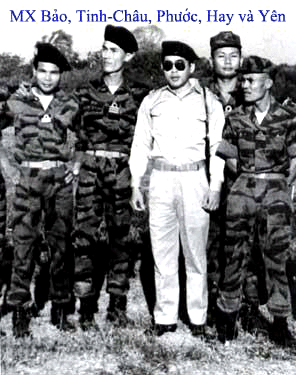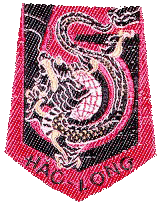Written by: First Lieutenant Duong Buu Long
In 1966, the 5th Battalion was performing operations within its TAOR in the province of Quang Ngai. Three months of tiring activity was finally coming to an end, and the day after the entire battalion would be airlifted to Saigon for an R & R. It was the battalion's last day in the province. The Battalion Commander - Major Duong Hanh Phuoc, was happy; he had just spoken with his wife on the telephone, promising to be there in Saigon on the morrow. But “tomorrow” turned out very differently for the 5th Battalion...
1. Calling a briefingA secret telegram sent from the Joint General Staff of the ARVN changed the plans of the battalion drastically. Calling a briefing, a rather disgruntled Commander read out the telegram's contents: “Upon receiving a last minute request, the Joint General Staff has decided to extend the 5th Battalion's period in the province of Quang Ngai by one day. After that, there will be no further prolongation of the battalion's stay in the province...” The details of the operation to be undertaken were gradually spelt out at the briefing. The 5th Battalion was to be present at the Quang Ngai airfield at 8.00am the following day, where it would be airlifted to a landing zone near target D. From there it was to advance and invade four different targets successively: targets D, C, B, and A. According to Intelligence sources, there were enemy troops lurking about the area - in addition to that, the inhabitants were decidedly pro-communists. There was to be an armor unit (accompanied by infantrymen) positioned between National Route 1 and target A: these men were to act as a reserve. The operation was to be completed in the one day. The map showed that the route along which the troops would advance was flanked by villages, and that the targets themselves were surrounded by houses. The length of the advancing route was 20km. On the left of the area of operation was a river, to the right, a rice field. 2. Progress of the Operation10.00am : Helicopter lift and landing completed - the 5th Battalion was divided into two groups: Alpha Command Group, commanded by Major Duong Hanh Phuoc, and composed of my 4th Company, the Battalion Commander and Staff of Alpha Command Group, and last but not least, First Lieutenant Nguyen Van Phan's 2nd Company. Bravo Command Group was commanded by the Battalion Executive Officer. In this group was to be found the 1st Company, Bravo Command Group Staff, and the 3rd Company. The Bravo Command Group advanced in parallel with the Alpha Group, but a little to the latter's left. The advance was slow; most the houses along the route were rigged with booby traps, and many harbored tunnels which led off to one or two underground bunkers. It was no easy feat trying to discover all the booby traps, and many grenades and smoke grenades were wasted in the process. 12.30 : The 4th Company succeeded in occupying Target D safely. On the advance to Target C, there were numerous skirmishes, for we were encountering the Viet Cong who had fled Target D and were on their retreat to Target C. Two Marines were slightly wounded, but the tally of the enemy's losses remained unknown at that stage. 16.20 : The 4th Company invaded Target C. I then asked the Battalion Commander if we might find places to position the units overnight, thus giving us the time to organize more ammunition particularly grenades. As I saw it, it was necessary to pass the night since there was not enough time left to try to occupy the remaining targets, which were another 10km away. Besides, the 4th Company had not enough grenades and smoke grenades to deal with heavy fighting, should it ensue. But the Battalion Commander had had orders which said that the fighting was to be completed in the course of the one day, and he refused my request. We were duly ordered to press on and occupy the remaining targets as fast as possible. Spending a significantly less amount of time on searching for booby traps and bunkers, the 4th Company sped on. 16.40 : After we had crossed an empty piece of land, the 4th Company encountered a man made trench: its width was about 1.5m, its depth around 2m. The trench lay perpendicular to our advance. About 15m behind the trench were thick bamboo hedges, running parallel to the trench. Hidden in foxholes and bunkers behind the hedge the enemy suddenly opened fire. Two machine guns were position on the left and right ends of the hedge and they sprayed forth bullets unceasingly. A few of our platoons were at that moment in the open, and they quickly leapt into the empty trench. As it was so deep, firearms were useless. The Marines there could only rely on their grenades. The remaining platoons moved off towards the right, and shot back at the enemy, ducking for cover behind the edge of the field. Right from the start the fight was savage. Grenades exploding shook the earth, whilst the NVA's B40s and B41s fell from the sky in a rain of fire. The Alpha Command Group Staff was positioned a little way off to my left. On my right, at the distance of about 100m, an NVA contingent was firing at us with 57mm recoilless rifles. One of these rounds exploded right where the Battalion Commander and Staff were situated. Nearly all those there were killed instantly: the Battalion Commander - Major Phuoc, First Lieutenant - Dr Le Huu Sanh, Capt. Thomas Kennedy USMC Advisors, an Artillery Forward observer, under officers, signalmen, and the Battalion Commander's body guards. Only the S3 officer and his signalman survived. Immediately after everyone around him had been killed, both the S3 officer and I tried to make radio contact with the Battalion Executive Officer, to tell him what had just happened, but Major Pham Nha was not to be reached... somehow the communications would not go through. The 4th Company found itself in an even worse situation when its Company Staff lost radio contact with the 1st, 2nd, and 3rd platoons - all one after another. Fifteen minutes later, the Marines who had been in the front line were pushed back from the canal. Herds of NVA, naked to the waist, with camouflage scarves around their necks, were hard on the heels of the retreating Marines. Their advance was suddenly halted by the 4th Company's heavy weapons platoon: a great number of them were killed, and the survivors bolted back with haste to their previous positions. I organized the remaining Marines into positions, ready for the next wave of NVA attack. I assessed the damage: the 4th Company had incurred quite a few losses. Many privates and under officers had been killed, some were wounded or missing in action. It was the same story with three of the platoon leaders: Warrant Officer Tran Tu Phuong, the 3rd platoon leader had been killed. The leaders of the 1st and 2nd platoon were missing in action. The following day, the 4th Company was informed that the 1st platoon leader - Warrant Officer Loc, had led his Marines fighting through a sea of Viet Cong, and to the safety of the ARVN unit positioned relatively far away... all this in spite of the fact that he himself had been wounded in the arm. Meanwhile, also in the same situation as my company, First Lieutenant Phan's 2nd Company had also been under heavy attack. Since they had been initially placed at the rear to protect the entire Alpha Command Group, when they were forced by the enemy to retreat, they did, only their retreat technically amounted to moving forwards towards my company. So now, we had two companies, the 2nd and the 4th both squashed in the one small area. The situation was hardly ameliorated by the constant rain of fire from the enemy's 57mm recoiless rifles, B40s and B41s. The two Companies had to fight by themselves - they had no radio communication with the Battalion Executive Officer's Bravo Command Group, and they had no artillery nor air fire support. Wedged together in the same area with little ammunition, the two companies were sitting ducks. Given the overwhelmingly unfavorable position, we were obliged to retreat to the riverbank to conserve the last of our strength whilst we awaited reinforcements. Much to our surprise, we managed to meet up with Bravo Command Group at the river bank, where they were already well established in deep trenches. After some salvos of artillery fire aimed at the enemy, the Battalion Executive Officer ordered the 4th Company to charge again - not once, but twice! And all this in spite of the fact that I no longer had a single platoon leader left. The enemy fire was strong, and we were repelled both times. We lost three more Marines in the futile attempts to charge, bringing our total or dead or wounded in the 4th Company to 34. 17.30 - 18.00 : The 5th Marine Battalion received word that a high ranking officer would soon be landing; the battalion was to prepare the area and protect the landing zone. A helicopter appeared soon after and landed quickly. An American Colonel in the uniform of the Marines alighted. He addressed the entire battalion, discussing the current condition as it concerned both us and the enemy. Then he made radio contact with the US 7th Fleet, requesting air fire support. Phantom Fighters soon appeared and bombarded the targets. There were in total three waves of air raids, and the targets were hidden in a sea of fire. 7.00am the following morning. The 5th Marine Battalion launched a counterattack. They invaded the set targets, and accomplished the mission. Conclusion:The battle has long gone, but there remains a number of questions which bother me still. Too many issues have never been definitively clarified. For
instance, the unnaturally well informed enemy: it seemed that they
knew our every step, including the ones we had not even taken yet.
Whilst their simultaneous frontal and rear assault could be
dismissed as chance, when the battle was over we discovered how
suspiciously well prepared they had been. For example, their fox
holes and trenches along the bamboo hedge was no overnight effort.
Furthermore, these trenches were filled to the brim with an
excessive number of grenades... far more than was “usual”. One had
the impression that they had long prepared themselves for a heavy
fight. Rumor had it that “someone” of significance in the province
of Quang Ngai had a hand in luring the battalion into the trap. It
was commonly believed that a NVA spy had somehow managed to worm his
way into a top position in Quang Ngai Province Staff, a position
which was significant enough to allow him to make requests and
orders - like that demanding the 5th Battalion to stay back for just
one more day.
email bixitrum@yahoo.com |
|||||
|
|||||
|
|||||

